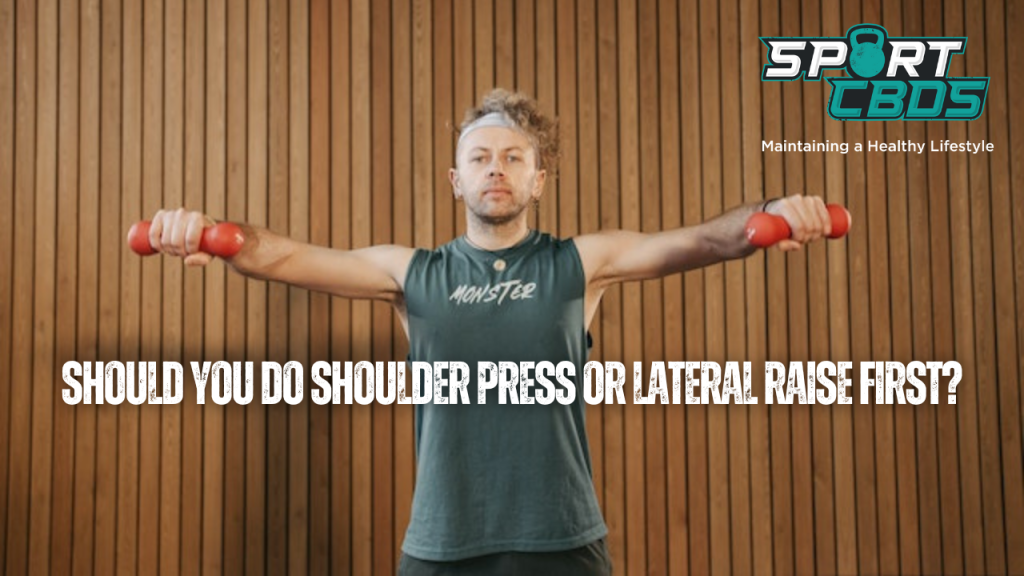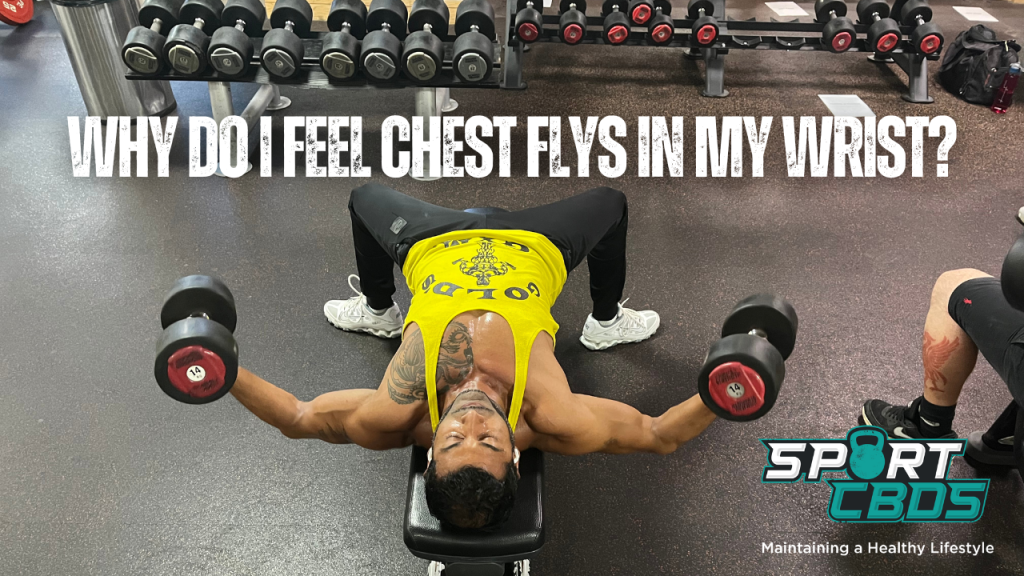
Decoding the Best Order: Shoulder Press or Lateral Raise First?
In the world of fitness and bodybuilding, the order of exercises in a workout routine is often a topic of debate.
The sequence can significantly impact the effectiveness of the workout and the results you achieve.
This article focuses on two popular shoulder exercises: the Shoulder Press and the Lateral Raise. We’ll delve into the question: which should you do first?
Should You Do Shoulder Press or Lateral Raise First?
The debate between performing the Shoulder Press or Lateral Raise first in a workout routine is a common one among fitness enthusiasts. The Shoulder Press, a compound exercise, targets multiple muscle groups, including the deltoids, trapezius, triceps, and upper pectoral muscles. It’s often recommended to start with this exercise due to its ability to engage more muscles and allow for heavier weights, leading to greater overall muscle development. On the other hand, the Lateral Raise, an isolation exercise, specifically targets the lateral deltoids, contributing to shoulder width and definition. Some argue for starting with this exercise to pre-exhaust the deltoids, making subsequent exercises more challenging and potentially leading to greater muscle growth. The decision between the two should be based on individual fitness goals, strength and endurance levels, and potential risk of injuries. Ultimately, both exercises are beneficial for shoulder development and can be incorporated into a balanced workout routine.
Understanding Shoulder Press and Lateral Raise
Shoulder Press
The Shoulder Press is a compound exercise that primarily targets the deltoids, the large muscles that cap your shoulders. It also engages several other muscles in your upper body, including the trapezius, triceps, and the upper pectoral muscles.
The Shoulder Press can be performed using dumbbells, a barbell, or a shoulder press machine. The exercise involves pressing the weight overhead from a position at shoulder level. This movement helps develop strength and muscle mass in the upper body, particularly the shoulders.
Lateral Raise
The Lateral Raise is an isolation exercise that specifically targets the lateral or middle part of the deltoids. This exercise is crucial for achieving that broad-shouldered look many fitness enthusiasts desire.
The Lateral Raise is typically performed with dumbbells. The exercise involves lifting the weights out to your sides until your arms are parallel with the floor, with a slight bend in the elbows. This movement helps isolate and work the lateral deltoids, enhancing shoulder width and definition.
Muscles Targeted by Each Exercise
While both exercises target the deltoids, they emphasize different parts of these muscles and engage other muscles to varying degrees:
- Shoulder Press: This exercise primarily targets the anterior (front) deltoids but also engages the lateral (middle) and posterior (rear) deltoids. The triceps and upper chest muscles also play a significant role in this exercise.
- Lateral Raise: This exercise isolates the lateral deltoids, making it an excellent exercise for targeting this often underworked muscle. While the anterior and posterior deltoids are also engaged, the focus is on the lateral deltoids.
Understanding these exercises and the muscles they target is crucial when deciding which exercise to perform first in your workout routine. The decision can impact the effectiveness of your workout and the development of your shoulder muscles.
The Debate: Shoulder Press or Lateral Raise First?
When it comes to the order of shoulder exercises, there are two main schools of thought. Some argue for starting with the Shoulder Press, while others advocate for the Lateral Raise. Let’s explore both perspectives.
Arguments for Doing Shoulder Press First
The Shoulder Press is a compound exercise, meaning it works multiple muscle groups at once. Many fitness experts suggest starting your workout with compound exercises for several reasons:
- Greater Energy Expenditure: Compound exercises like the Shoulder Press require more energy, so it makes sense to do them first when your energy levels are highest.
- More Muscle Activation: The Shoulder Press activates more muscles, which can lead to greater overall muscle development.
- Heavier Weights: You can typically lift heavier weights in a Shoulder Press compared to a Lateral Raise. Lifting heavier weights first can maximize strength gains.
Arguments for Doing Lateral Raise First
On the other hand, some argue for starting with the Lateral Raise. Here’s why:
- Targeted Muscle Activation: The Lateral Raise specifically targets the lateral deltoids, which can be beneficial if this is a weak area for you.
- Pre-exhaustion Technique: Doing the Lateral Raise first can pre-exhaust the deltoids, making the Shoulder Press more challenging and potentially leading to greater muscle growth.
- Lower Risk of Injury: The Lateral Raise is generally a safer exercise, as it uses lighter weights and has a lower risk of injury.
Expert Opinions and Research Findings
Most experts agree that the order of exercises should depend on your individual goals. If your goal is overall strength and muscle development, starting with the Shoulder Press might be more beneficial. However, if you want to focus on the lateral deltoids or use the pre-exhaustion technique, starting with the Lateral Raise could be a better choice.
Related: Why Do My Ribs Hurt When I Shoulder Press? (Causes and Prevention)
Factors to Consider When Choosing the Order of Exercises
When deciding whether to do the Shoulder Press or Lateral Raise first, consider the following factors:
- Individual Fitness Goals: If your goal is to build overall shoulder strength and size, you might want to start with the Shoulder Press. If you’re aiming to specifically target the lateral deltoids, starting with the Lateral Raise might be more beneficial.
- Strength and Endurance Levels: If you have high strength and endurance levels, you might be able to start with the more challenging Shoulder Press. However, if you’re a beginner or have lower strength levels, starting with the Lateral Raise might be a safer choice.
- Potential Risk of Injuries: If you have any shoulder injuries or are prone to them, you might want to start with the Lateral Raise, which generally has a lower risk of injury.
The order of exercises in your workout should be tailored to your individual needs and goals. It’s always a good idea to consult with a fitness professional to ensure you’re making the best choices for your health and fitness journey.
Grip Strength Is Crucial
Grip strength plays a crucial role in exercises like the Shoulder Press and Lateral Raise. A strong grip allows you to hold and control the weights more effectively, which can lead to better performance and results.
It also helps in maintaining proper form and reducing the risk of injury. A study published in the Journal of Strength and Conditioning Research found that grip strength can significantly influence performance in upper body resistance training. To improve your grip strength, consider using tools like the hand grip strengthener available on Amazon.
Additionally, products like those found on Sport CBDs can aid in recovery and muscle relaxation, further enhancing your workout performance. By combining strength training with effective recovery practices, you can optimize your workouts, whether you choose to do Shoulder Press or Lateral Raise first.
Awesome Shoulder Workout
Here’s a detailed shoulder workout routine incorporating both the Shoulder Press and Lateral Raise:
Warm-up: Start with a 10-minute warm-up to get your blood flowing and prepare your muscles for the workout. This could include light cardio like jogging or jumping jacks, or dynamic stretches that target the upper body.
Shoulder Press: Start with 4 sets of 8-10 reps. Choose a weight that is challenging but allows you to maintain proper form. Rest for about 60-90 seconds between sets.
Lateral Raise: Follow with 4 sets of 12-15 reps. This exercise typically requires lighter weights than the Shoulder Press. Again, choose a weight that allows you to maintain proper form. Rest for about 60-90 seconds between sets.
Front Dumbbell Raise: This exercise targets the anterior deltoids. Perform 3 sets of 12-15 reps with each arm. Rest for about 60 seconds between sets.
Rear Delt Fly: This exercise targets the posterior deltoids. Perform 3 sets of 12-15 reps. Rest for about 60 seconds between sets.
Dumbbell Shrug: This exercise targets the trapezius muscles, which are also important for a well-rounded shoulder workout. Perform 3 sets of 12-15 reps. Rest for about 60 seconds between sets.
Cool-down: Finish your workout with a cool-down period to help your body recover. This could include light cardio to lower your heart rate gradually, and static stretches to help relax your muscles.
Remember, it’s important to listen to your body and adjust the workout as needed based on your fitness level and goals. Always prioritize proper form over lifting heavier weights to avoid injury. If you’re new to these exercises or unsure about your form, consider seeking advice from a fitness professional.
Related: Busting Myths: Are Incline Bench and Lateral Raises Enough to Develop Shoulders?
FAQs
Here are some frequently asked questions related to the topic:
Can I do Shoulder Press and Lateral Raise on the same day?
Yes, you can do both exercises on the same day. They target different parts of the deltoids, so they can complement each other in a shoulder workout.
Which exercise is better for shoulder development, Shoulder Press or Lateral Raise?
Both exercises are beneficial for shoulder development. The Shoulder Press is a compound exercise that targets multiple muscles, while the Lateral Raise is an isolation exercise that specifically targets the lateral deltoids.
Should I lift heavy or light for shoulders?
It depends on your goals. If you’re aiming for strength and size, lifting heavier weights can be beneficial. If you’re focusing on muscle endurance or toning, lighter weights with more repetitions can be effective.
Final Thoughts…
Both the Shoulder Press and Lateral Raise are effective exercises for developing the shoulders. The decision on which to perform first should be based on your individual fitness goals, strength and endurance levels, and potential risk of injuries.
While some may argue for the Shoulder Press due to its compound nature and ability to lift heavier weights, others may advocate for the Lateral Raise for its targeted muscle activation and lower risk of injury. Ultimately, the choice is yours to make based on your personal needs and goals.
Remember, consistency and proper form are key to achieving your fitness goals. Always consult with a fitness professional if you’re unsure about your workout routine. Happy lifting!
Which order do you think is best when it comes to your shoulders? Have our tips been beneficial to your training? We’d love to hear your feedback, so please share your thoughts in the comments section below.
If you’re a sports enthusiast who utilizes CBD for optimal recovery after intense workouts, then you’ve found your tribe. Welcome to Sport CBDs, where we push our limits in training and prioritize recovery in the most effective way possible.
We regularly share workout routines on our YouTube channel and offer a range of health and fitness products designed to give you that competitive edge.
Why not explore the high-quality CBD products we proudly feature on our site? Visit the Sport CBDs Store by clicking here. In addition to CBD, we also offer an array of fitness clothing and yoga accessories to complement your active lifestyle.
Until next time, we wish you the best in your fitness journey. Remember, your progress is our passion. Stay strong and keep pushing!


